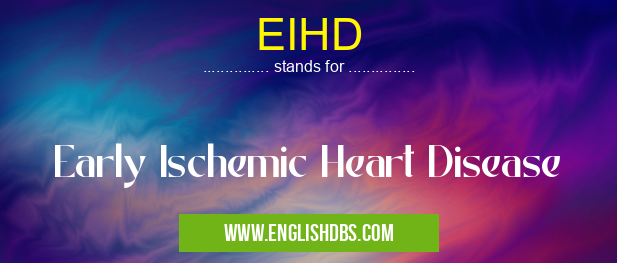What does EIHD mean in DISEASES
EIHD stands for Early Ischemic Heart Disease. It is a condition in which the blood flow to the heart is reduced, often due to a buildup of plaque in the arteries that supply blood to the heart muscle. This can lead to chest pain, shortness of breath, and other symptoms. If left untreated, EIHD can lead to a heart attack.

EIHD meaning in Diseases in Medical
EIHD mostly used in an acronym Diseases in Category Medical that means Early Ischemic Heart Disease
Shorthand: EIHD,
Full Form: Early Ischemic Heart Disease
For more information of "Early Ischemic Heart Disease", see the section below.
What Causes EIHD
The most common cause of EIHD is atherosclerosis, a condition in which plaque builds up in the arteries. Plaque is made up of cholesterol, fat, calcium, and other substances. Over time, plaque can narrow the arteries and reduce blood flow to the heart.
Other risk factors for EIHD include:
- High blood pressure
- High cholesterol
- Diabetes
- Obesity
- Smoking
- Family history of heart disease
Symptoms of EIHD
The most common symptom of EIHD is chest pain, which is often described as a pressure or squeezing sensation in the chest. Other symptoms of EIHD can include:
- Shortness of breath
- Fatigue
- Lightheadedness
- Dizziness
- Nausea
- Vomiting
Diagnosis of EIHD
EIHD is diagnosed based on a physical examination, a medical history, and a variety of tests, including:
- Electrocardiogram (ECG): An ECG records the electrical activity of the heart. It can help to identify abnormalities in the heart's rhythm and structure.
- Echocardiogram: An echocardiogram uses ultrasound to create images of the heart. It can help to assess the heart's structure and function.
- Cardiac catheterization: Cardiac catheterization is a procedure in which a thin tube is inserted into an artery in the arm or leg and guided to the heart. It can be used to measure blood pressure in the heart and to identify blockages in the arteries.
Treatment of EIHD
The treatment of EIHD depends on the severity of the condition. Treatment options may include:
- Medications: Medications can be used to lower blood pressure, reduce cholesterol, and prevent blood clots.
- Lifestyle changes: Lifestyle changes, such as quitting smoking, eating a healthy diet, and exercising regularly, can help to reduce the risk of heart disease.
- Surgery: Surgery may be necessary to bypass blocked arteries or to repair damaged heart valves.
Essential Questions and Answers on Early Ischemic Heart Disease in "MEDICAL»DISEASES"
What is Early Ischemic Heart Disease (EIHD)?
Early Ischemic Heart Disease (EIHD) is a condition in which the blood supply to the heart is reduced, leading to a lack of oxygen to the heart muscle. It is often caused by a buildup of plaque in the arteries that supply blood to the heart. Plaque is made up of cholesterol, fat, calcium, and other substances. When plaque builds up, it can narrow the arteries and restrict blood flow. EIHD can lead to chest pain, shortness of breath, and other symptoms. If left untreated, EIHD can increase the risk of heart attack and stroke.
What are the symptoms of EIHD?
The most common symptom of EIHD is chest pain, which is often described as a squeezing or pressure in the chest. Chest pain can also be accompanied by shortness of breath, fatigue, nausea, and lightheadedness. EIHD can also cause pain in the arms, neck, back, or jaw. If you experience any of these symptoms, it is important to see a doctor right away.
What are the risk factors for EIHD?
There are several risk factors for EIHD, including:
- High blood pressure
- High cholesterol
- Diabetes
- Smoking
- Obesity
- Family history of heart disease
- Age (over 55 for men and over 65 for women)
How is EIHD diagnosed?
EIHD is diagnosed through a physical exam, medical history, and tests such as an electrocardiogram (ECG), echocardiogram, and stress test. An ECG measures the electrical activity of the heart, an echocardiogram uses sound waves to create images of the heart, and a stress test measures how the heart responds to exercise.
How is EIHD treated?
Treatment for EIHD depends on the severity of the condition. Treatment options may include:
- Medications to lower blood pressure, cholesterol, and blood sugar
- Lifestyle changes, such as quitting smoking, eating a healthy diet, and exercising regularly
- Angioplasty and stenting, which are procedures to open up narrowed arteries
- Coronary artery bypass surgery, which is a surgery to create new pathways for blood to flow to the heart
Final Words: EIHD is a serious condition that can lead to a heart attack. However, it can be prevented and treated with lifestyle changes, medications, and surgery. If you have any symptoms of EIHD, it is important to see a doctor right away. Early diagnosis and treatment can help to improve your prognosis.
